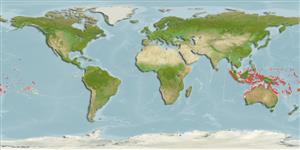>
Gobiiformes (Gobies) >
Gobiidae (Gobies) > Gobiinae
Etymology: Eviota: No etymology given, suggested by Christopher Scharpt: from Latin 'eu' for 'true' and 'iota' for anything very small, in combination 'truly very small' referring to it as being the smallest vertebrate at the time it has benn described by Jenkins (thus, making the suggestion by Scharpt plausible.
Eponymy: Dr Albert William Christian Theodore Herre (1868–1962) was an ichthyologist, ecologist, botanist and lichenologist. [...] (Ref. 128868), visit book page.
More on authors: Jordan & Seale.
Environment: milieu / climate zone / depth range / distribution range
Ecología
marino asociado a arrecife; rango de profundidad 0 - 6 m (Ref. 86942). Tropical; 8°N - 28°S
Indo-Pacific: Samoa (other records from throughout the Indo-Pacific Ocean may represent a species complex); also eastern Indian Ocean, Indonesia; north to Japan (Ryukyu Islands); east to French Polynesia (Rapa); south to Australia (Great Barrier Reef).
Tamaño / Peso / Age
Maturity: Lm ? range ? - ? cm
Max length : 1.4 cm SL macho / no sexado; (Ref. 1602)
Short description
Claves de identificación | Morfología | Morfometría
Espinas dorsales (total) : 7; Radios blandos dorsales (total) : 8; Espinas anales: 1; Radios blandos anales: 8. Characterized by the following: dorsal to anal fin-ray formula 8/8; translucent greyish with orange scale margins; presence of six faint internal dark bars ventrally on body just above base of anal-fin to caudal peduncle; close-set, cheek with close-set, irregular dusky brown spots; ninth to fourteenth pectoral rays usually branched; longitudinal scale series 21-24; ctenoid scales, absent in head, nape, chest and pectoral fin base; separated pelvic fins, thin membrane joining bases; 4-7 branches on fourth pelvic ray; depth of body 3.5-4.1 in SL (Ref. 90102).
Life cycle and mating behavior
Madurez | Reproducción | Puesta | Huevos | Fecundidad | Larva
Myers, R.F., 1991. Micronesian reef fishes. Second Ed. Coral Graphics, Barrigada, Guam. 298 p. (Ref. 1602)
IUCN Red List Status (Ref. 130435: Version 2024-1)
Threat to humans
Harmless
Human uses
Herramientas
Special reports
Download XML
Fuentes de Internet
Estimates based on models
Preferred temperature (Ref.
123201): 25.4 - 29.3, mean 28.6 °C (based on 1840 cells).
Phylogenetic diversity index (Ref.
82804): PD
50 = 0.5000 [Uniqueness, from 0.5 = low to 2.0 = high].
Bayesian length-weight: a=0.00692 (0.00284 - 0.01683), b=3.10 (2.92 - 3.28), in cm total length, based on LWR estimates for this Genus-body shape (Ref.
93245).
Nivel trófico (Ref.
69278): 3.0 ±0.3 se; based on size and trophs of closest relatives
Resiliencia (Ref.
120179): Alto, población duplicada en un tiempo mínimo inferior a 15 meses (Preliminary K or Fecundity.).
Fishing Vulnerability (Ref.
59153): Low vulnerability (10 of 100).
Nutrients (Ref.
124155): Calcium = 818 [286, 4,225] mg/100g; Iron = 2.81 [0.89, 7.90] mg/100g; Protein = 17.4 [15.0, 19.7] %; Omega3 = 0.0895 [, ] g/100g; Selenium = 42.3 [6.7, 207.2] μg/100g; VitaminA = 72.3 [7.5, 660.2] μg/100g; Zinc = 8.39 [3.46, 17.02] mg/100g (wet weight);
